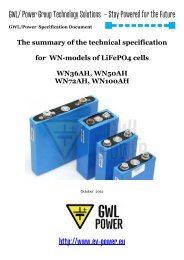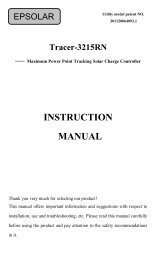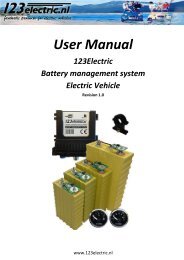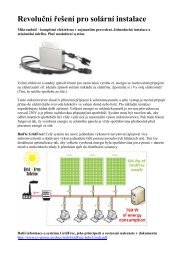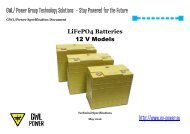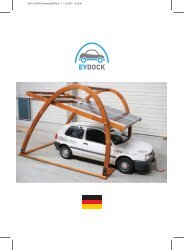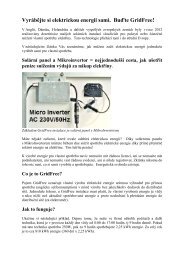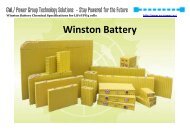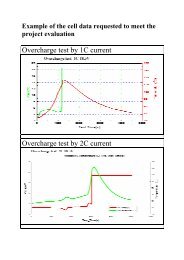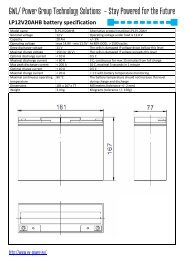INSTRUCTION MANUAL
INSTRUCTION MANUAL
INSTRUCTION MANUAL
Create successful ePaper yourself
Turn your PDF publications into a flip-book with our unique Google optimized e-Paper software.
Tracer-2210RN / 2215RN<br />
—— Maximum Power Point Tracking Solar Charge Controller<br />
Thank you very much for selecting our product!<br />
This manual offers important information and suggestions with respect to<br />
installation, use and troubleshooting, etc. Please read this manual carefully<br />
before using the product and pay attention to the safety recommendations<br />
in it.<br />
EPSOLAR<br />
<strong>INSTRUCTION</strong><br />
<strong>MANUAL</strong><br />
Utility model patent NO.<br />
201120064092.1
Tracer-2210RN / 2215RN<br />
—— Maximum Power Point Tracking Solar Charge Controller<br />
Specification Summary<br />
System Voltage 12 / 24VDC<br />
Rated Battery Current 20A<br />
Rated Load Current 20A<br />
Max. PV Input Voltage**<br />
Tracer-2210RN 100VDC<br />
Tracer-2215RN 150VDC<br />
Max. PV Input Power<br />
12V System 260W<br />
24V System 520W<br />
**Array voltage should never exceed maximum PV input voltage. Refer to the solar module<br />
documentation to determine the highest expected array Voc (open circuit voltage) as defined by the<br />
lowest expected ambient temperature for the system location.
Contents<br />
1 Important Safety Information ............................................... 1<br />
2 General Information ............................................................. 2<br />
2.1 Overview .................................................................. 2<br />
2.2 Optional Accessories................................................ 4<br />
3 Installation Instructions ........................................................ 4<br />
3.1 General Installation Notes ........................................ 4<br />
3.2 Mounting .................................................................. 4<br />
3.3 Wiring ...................................................................... 5<br />
4 Operation ............................................................................ 10<br />
4.1 MPPT Technology ................................................. 10<br />
4.2 Battery Charging Information ................................ 11<br />
4.3 LED Indications ..................................................... 13<br />
4.4 Setting Operation ................................................... 14<br />
5 Protections, Troubleshooting and Maintenance ................. 20<br />
5.1 Protection ............................................................... 20<br />
5.2 Troubleshooting ..................................................... 20<br />
5.3 Maintenance ........................................................... 22<br />
6 Warranty ............................................................................ 23<br />
7 Technical Specifications .................................................... 24
1 Important Safety Information<br />
Save These Instructions<br />
This manual contains important safety, installation and operating instructions for<br />
Tracer.<br />
The following symbols are used throughout this manual to indicate potentially<br />
dangerous conditions or mark important safety instructions,please take care when<br />
meeting these symbols.<br />
General Safety Information<br />
WARNING: Indicates a potentially dangerous condition.<br />
Use extreme caution when performing this task.<br />
CAUTION: Indicates a critical procedure for safe and proper<br />
operation of the controller<br />
NOTE: Indicates a procedure or function that is important for the<br />
safe and proper operation of the controller.<br />
· Read all of the instructions and cautions in the manual before beginning installation.<br />
·There are no user serviceable parts inside the Tracer. Do not disassemble or attempt to<br />
repair the controller.<br />
·Disconnect the solar module and fuse/breakers near to battery before installing or<br />
adjusting the Tracer.<br />
·Install external fuses/breakers as required.<br />
·Do not allow water to enter the controller.<br />
·Confirm that power connections are tightened to avoid excessive heating from loose<br />
connection.<br />
1
2 General Information<br />
2.1 Overview<br />
Thank you for selecting the Tracer controller which represents advanced technology of<br />
our company. The features are listed below:<br />
·12V / 24V auto recognition.<br />
·Advanced maximum power point tracking technology to optimize using the solar<br />
system.<br />
·Peak conversion efficiency of 97 %, high Tracking efficiency of 99%.<br />
·Very fast sweeping of the entire I-V curve, several seconds tracking speed.<br />
·Widely used, automatic recognize day/night.<br />
·Timer function with 1-15 hours option for street light.<br />
·Unique dual timer function, enhance the flexibility of street light system.<br />
·Sealed, Gel and Flooded battery option.<br />
·Adopting temperature compensation and correcting the charging and discharging<br />
parameters automatically, improving the battery lifetime.<br />
·Electronic protection: over charging, over discharging, overload, short circuit.<br />
·Reverse protection: any combination of solar module and battery, without causing<br />
damage to any component.<br />
·Excellent thermal design and nature air cooling.<br />
·RJ45 interface with remote meter MT-5, convenient to check operating parameters of<br />
controllers.<br />
The Tracer series controller is for off-grid solar system and control the charging<br />
and discharging of the battery, especially suitable for the street light system. The<br />
controller features a smart tracking algorithm inside that maximizes the energy from<br />
the solar PV module(s) and charge the battery. At the same time, the low voltage<br />
disconnect function (LVD) will prevent the battery from over discharging.<br />
The Tracer controller charging process has been optimized for long battery life<br />
and improved system performance. The comprehensive self-diagnostics and electronic<br />
protection functions can prevent damage from installation mistakes or system faults. In<br />
addition, the Tracer controller has a RJ45 interface to allow communication with a<br />
meter for remote monitoring.<br />
Although the Tracer controller is very simple to configure and use, please take<br />
your time to read the operator's manual and become familiar with the controller. This<br />
will help you make full use of all the functions and improve your solar PV system.<br />
2
The features of Tracer controller:<br />
1 – Charging Status LED Indicator<br />
An LED indicator that shows charging status and overvoltage of battery.<br />
2 – Battery Status LED Indicator<br />
An LED indicator that shows battery status or system errors.<br />
3 – Temperature Sensor<br />
Measure ambient temperature and make temperature compensation for charging and<br />
discharging.<br />
1<br />
1<br />
4 – Setting Indicators<br />
Corresponding indicator will be on when set timer1, timer2 and battery type.<br />
5 – LED Digital Display<br />
Display the load work mode and status.<br />
6 – Setting Button (in manual mode used for load ON/OFF)<br />
Set load work mode and select battery type.<br />
7 – Solar Module Terminals<br />
Connect solar modules.<br />
8 – Battery Terminals<br />
Connect batteries.<br />
9 – Load Terminals<br />
Connect loads.<br />
2<br />
1<br />
3<br />
1<br />
7 8 9 10<br />
1 1 1 1<br />
Figure 2-1 Tracer Characteristics<br />
10 – RJ45 Communication Interface<br />
4<br />
1<br />
Communicate with remote meter MT-5.<br />
3<br />
5<br />
1<br />
6<br />
1
2.2 Optional Accessories<br />
Remote Meter(Model:MT-5)<br />
The digital remote meter displays system operating information, error indications,<br />
and self-diagnostics read-out. Information is displayed on a backlit LCD display. The<br />
large numerical display and icons are easy to read and large buttons make navigating<br />
the meter menus easy. The meter can be flush mounted in a wall or surface mounted<br />
using the mounting frame (included). The MT-5 is supplied with 2m of cable and a<br />
mounting frame. The MT-5 connects to the RJ45 port on the Tracer.<br />
3 Installation Instructions<br />
3.1 General Installation Notes<br />
Read through the entire installation section first before beginning installation.<br />
Be very careful when working with batteries. Wear eye protection. Have fresh water<br />
available to wash and clean any contact with battery acid.<br />
Uses insulated tools and avoid placing metal objects near the batteries.<br />
Explosive battery gasses may be present during charging. Be certain there is<br />
sufficient ventilation to release the gasses.<br />
Avoid direct sunlight and do not install in locations where water can enter the<br />
controller.<br />
Loose power connections and/or corroded wires may result in resistive connections<br />
that melt wire insulation, burn surrounding materials, or even cause fire. Ensure<br />
tight connections and use cable clamps to secure cables and prevent them from<br />
swaying in mobile applications.<br />
Use with Gel, Sealed or Flooded batteries only.<br />
Battery connection may be wired to one battery or a bank of batteries. The following<br />
instructions refer to a singular battery, but it is implied that the battery connection<br />
can be made to either one battery or a group of batteries in a battery bank.<br />
Select the system cables according to 3A/mm 2 current density.<br />
3.2 Mounting<br />
NOTE: When mounting the Tracer, ensure free air through the controller heat<br />
sink fins. There should be at least 150mm of clearance above and below the<br />
controller to allow for cooling. If mounted in an enclosure, ventilation is highly<br />
recommended.<br />
WARNING: Risk of explosion! Never install the Tracer in a sealed enclose with<br />
flooded batteries! Do not install in a confined area where battery gas<br />
can accumulate.<br />
4
Step 1: Choose Mounting Location<br />
Locate the Tracer on a vertical surface protected from direct sun, high<br />
temperature, and water.<br />
Step 2: Check for Clearance<br />
Place the Tracer in the location where it will be mounted. Verify that there is<br />
sufficient room to run wires and that there is sufficient room above and below the<br />
controller for air flow.<br />
Step 3: Mark Holes<br />
surface.<br />
Figure 3-1 Mounting and cooling<br />
Use a pencil or pen to mark the four (4) mounting hole locations on the mounting<br />
Step 4: Drill Holes<br />
Remove the controller and drill four sizeable holes in the marked locations.<br />
Step 5: Secure Controller<br />
Place the controller on the surface and align the mounting holes with the drilled<br />
holes in step 4. Secure the controller in place using the mounting screws.<br />
3.3 Wiring<br />
150mm<br />
150mm<br />
NOTE: A recommended connection order has been provided for maximum<br />
safety during installation.<br />
NOTE: The Tracer is a negative ground controller. Any negative connection of<br />
solar module, battery or load can be earth grounded as required. Grounding is<br />
recommended.<br />
5<br />
Warm air<br />
Cool air
CAUTION: Don’t connect the loads with surge power exceeding the ratings of<br />
the controller.<br />
CAUTION: For mobile applications, be sure to secure all wiring. Use cable<br />
clamps to prevent cables from swaying when the vehicle is in motion. Unsecured<br />
cables create loose and resistive connections which may lead to excessive heating<br />
and/or fire.<br />
Step 1: Battery Wiring<br />
WARNING: Risk of explosion or fire! Never short circuit battery positive (+)<br />
and negative (-) or cables<br />
Figure 3-2 Battery wiring<br />
Before connecting the battery, measure the battery voltage. It must be over 9V to<br />
power the controller. For 24V, the voltage must be greater than 18V to properly detect<br />
a 24V battery. The 12/24V battery detection is automatic and the check is only<br />
performed at start-up.<br />
Wire an in-line fuse holder no more than 150mm from the battery positive<br />
terminal. Do not insert a fuse at this time. Confirm the connection correct and then<br />
turn on the power.<br />
6
Step 2: Load Wiring<br />
The Tracer load output can connect DC electronic devices of which rated voltage<br />
is same as battery’s. Tracer will provide battery voltage to the loads. See Section 4.4<br />
Setting Operation for more details about the load control.<br />
Figure 3-3 Load wiring<br />
Connect load positive (+) and negative (-) to the Tracer load output as shown in<br />
figure 3-3. The load terminals may exist voltage, connect carefully to avoid short<br />
circuit.<br />
An in-line fuse holder should be wired in series in the load positive (+) or<br />
negative (-) wire as shown. Do not insert a fuse at this time. Confirm the connection<br />
correct and then turn on the power.<br />
If wiring the load connection to a load distribution panel, each load circuit should<br />
be fused separately. The total load draw should not exceed the 20A load rating.<br />
Step 3:Solar Module Wiring<br />
WARNING: Risk of electric shock! Exercise caution when handling solar wiring.<br />
The solar module(s) high voltage output can cause severe shock or injury. Cover<br />
the solar module(s) from the sun before installing solar wiring.<br />
The Tracer can accept 12V, 24V nominal off-grid solar module arrays. Grid –tie<br />
solar module(s) may be used if the open circuit voltage does not exceed the maximum<br />
solar input rating. The solar module(s) nominal voltage must be equal to or greater<br />
than the nominal battery voltage.<br />
Fuse Load<br />
7
Solar Module<br />
Step 4: Accessories (option)<br />
Figure3-4 Solar Module wiring<br />
Install Remote Meter (purchased separately) if required. Refer to the instructions<br />
provided for detailed installation procedures.<br />
Step 5: Confirm Wiring<br />
Double-check the wiring in step1 through 4. Confirm correct polarity at each<br />
connection. Verify that all six power terminals are tightened.<br />
Solar Module<br />
Fuse<br />
Battery<br />
Figure3-5 System Wiring review<br />
8<br />
Fuse<br />
Load
Step 6: Confirm Power-up<br />
When battery power is applied and the Tracer powers up, the battery led indicator<br />
will be green.<br />
If the Tracer does not power up or battery status LEDs error exists, refer to<br />
Section 5 Troubleshooting<br />
9
4 Operation<br />
4.1 MPPT Technology<br />
The Tracer utilizes Maximum Power Point Tracking technology to extract<br />
maximum power from the solar module (s). The tracking algorithm is fully automatic<br />
and does not require user adjustment, Tracer technology will track the array maximum<br />
power point voltage (Vmp) as it varies with weather conditions, ensuring that<br />
maximum power is harvested from the array through the course of the day.<br />
· Current Boost<br />
In many cases, Tracer MPPT technology will ―boost‖ the solar charge current.<br />
For example, a system may have 8 Amps of solar current flowing into the Tracer and<br />
10 Amps of charge current flowing out to the battery. The Tracer does not create<br />
current! Rest assured that the power into the Tracer is the same as the power out of the<br />
Tracer. Since power is the product of voltage and current (Volts×Amps), the following<br />
is true*:<br />
(1) Power Into the Tracer =Power Out of the Tracer<br />
(2) Volts In×Amps In=Volts Out×Amps Out<br />
* Assuming 100% efficiency. Actually, the losses in wiring and conversion exist.<br />
If the solar module’s Vmp is greater than the battery voltage, it follows that the<br />
battery current must be proportionally greater than the solar input current so that input<br />
and output power are balanced. The greater the difference between the maximum<br />
power voltage and battery voltage, the greater the current boost. Current boost can be<br />
substantial in systems where the solar array is of a higher nominal voltage than the<br />
battery.<br />
· An Advantage Over Traditional Controllers<br />
Traditional controllers connect the solar module directly to the battery when<br />
recharging. This requires that the solar module operate in a voltage range that is below<br />
the module’s Vmp. In a 12V system for example, the battery voltage may range from<br />
11-15Vdc but the module’s Vmp is typically around 16 or 17V.<br />
Figure 4-1 shows a typical current VS. voltage output curve for a nominal 12V<br />
off-grid module.<br />
10
Current VS. Voltage in 12V system Output power in 12V system<br />
Tracer<br />
Typical Battery<br />
Voltage Range<br />
Maximum<br />
Power<br />
Point<br />
Traditional<br />
Controller<br />
Operating Range<br />
Maximum<br />
Power<br />
Point<br />
Figure 4-1 Nominal 12V Solar Module I-V curve and output power graph<br />
The array Vmp is the voltage where the product of current and voltage<br />
(Amps×Volts) is greatest, which falls on the ―knee‖ of the solar module I-V curve as<br />
shown in Figure4-1. Because Traditional controllers do not operate at the Vmp of the<br />
solar modules(s), energy is wasted that could otherwise be used to charge the battery<br />
and power system loads. The greater the difference between battery voltage and the<br />
Vmp of the module, the more energy is wasted.<br />
Tracer MPPT technology will always operate at the Vmp resulting in less wasted<br />
energy compared to traditional controllers.<br />
· Conditions That Limits the Effectiveness of MPPT<br />
The Vmp of a solar module decreases as the temperature of the module increases.<br />
In very hot weather, the Vmp may be close or even less than battery voltage. In this<br />
situation, there will be very little or no MPPT gain compared to traditional controllers.<br />
However, systems with modules of higher nominal voltage than the battery bank will<br />
always have an array Vmp greater than battery voltage. Additionally, the savings in<br />
wiring due to reduced solar current make MPPT worthwhile even in hot climates.<br />
4.2 Battery Charging Information<br />
Four Charging Stage<br />
The Tracer has a 4-stage battery charging algorithm for rapid, efficient, and safe<br />
battery charging.<br />
11
·Bulk Charge<br />
Figure 4-2 Tracer MPPT charging algorithm<br />
In this stage, the battery voltage has not yet reached boost voltage and 100% of<br />
available solar power is used to recharge the battery.<br />
·Boost Charge<br />
When the battery has recharged to the Boost voltage setpoint, constant-voltage<br />
regulation is used to prevent heating and excessive battery gassing. The Boost stage<br />
remains 120 minutes and then goes to Float Charge. Every time when the controller is<br />
powered on, if it detects neither over discharged nor overvoltage, the charging will<br />
enter into boost charging stage.<br />
·Float Charge<br />
After the Boost voltage stage, Tracer will reduce the battery voltage to Float<br />
voltage setpoint. When the battery is fully recharged, there will be no more chemical<br />
reactions and all the charge current transmits into heat and gas at this time. Then the<br />
Tracer reduces the voltage to the floating stage, charging with a smaller voltage and<br />
current. It will reduce the temperature of battery and prevent the gassing, also charging<br />
the battery slightly at the same time. The purpose of Float stage is to offset the power<br />
consumption caused by self consumption and small loads in the whole system, while<br />
maintaining full battery storage capacity.<br />
In Float stage, loads can continue to draw power from the battery. In the event<br />
that the system load(s) exceed the solar charge current, the controller will no longer be<br />
able to maintain the battery at the Float setpoint. Should the battery voltage remains<br />
below the boost reconnect charging voltage, the controller will exit Float stage and<br />
return to Bulk charging.<br />
12
·Equalize<br />
WARNING: Risk of explosion!<br />
Equalizing flooded battery can produce explosive gases, so well ventilation<br />
of battery box is necessary.<br />
NOTE: Equipment damage!<br />
Equalization may increase battery voltage to the level damaging to sensitive<br />
DC loads. Ensure that all load allowable input voltages are greater than the<br />
equalizing charging set point voltage.<br />
NOTE: Equipment damage!<br />
Over-charging and excessive gas precipitation may damage the battery plates<br />
and activate material shedding on them. Too high an equalizing charge or for<br />
too long may cause damage. Please carefully review the specific requirements<br />
of the battery used in the system.<br />
Certain types of batteries benefit from periodic equalizing charge, which can stir<br />
the electrolyte, balance battery voltage and complete chemical reaction. Equalizing<br />
charge increases the battery voltage, higher than the standard complement voltage,<br />
which gasifies the battery electrolyte.<br />
If it detects that the battery is being over discharged, the solar controller will<br />
automatically turn the battery to equalization charging stage, and the equalization<br />
charging will be 120mins. Equalizing charge and boost charge are not carried out<br />
constantly in a full charge process to avoid too much gas precipitation or overheating<br />
of battery.<br />
4.3 LED Indications<br />
Charging Indicator Battery Indicator LED Digital Tube<br />
Figure 4-3 LED Indicators<br />
13
Charging Indicator<br />
The green LED indicator will light whenever sunlight is available for battery<br />
charging, the green charging LED will stay on in normal charging. The charging LED<br />
indicator flashes when battery over voltage. Please refer to Chapter 5 for<br />
troubleshooting.<br />
Charging LED indicator Table4-1<br />
Battery Indicator<br />
Color Indication Operating State<br />
Green On Solid Charging<br />
Green Flashing Battery over-voltage<br />
GREEN ON when battery voltage in normal range<br />
GREEN FLASHING when battery full<br />
ORANGE ON when battery under voltage<br />
RED ON when battery over discharged<br />
Please refer to Chapter 5 for troubleshooting.<br />
Battery LED indicator Table 4-2<br />
PV Overvoltage Display<br />
Color Indication Operating State<br />
Green On solid Normal (battery)<br />
Green Flashing Full (battery)<br />
Orange On solid Under voltage(battery)<br />
Red On solid Over discharged(battery)<br />
If the solar input open circuit voltage (Voc) exceeds the maximum rating, the<br />
array will remain disconnected until the Voc falls safely below the maximum rating.<br />
PV Overvoltage LED Display Table 4-3<br />
Color Indication Operating State<br />
Red LED digital tube displays ―P‖ PV Overvoltage<br />
14
PV Overcurrent Display<br />
If the solar input current exceeds the maximum rating, the array will be<br />
disconnected automatically.<br />
PV Overcurrent LED Display Table 4-4<br />
Load indicator<br />
Color Indication Operating State<br />
Red LED digital tube displays ―C‖ PV Overcurrent<br />
When the load amp is 1.25times of rated current for 60 seconds, or the load amp<br />
is 1.5 times of rated current for 5 seconds (overload); or load short circuit, the Battery<br />
Indicator RED FLASHING. Please refer to section 5 for troubleshooting.<br />
Load LED indicator Table 4-5<br />
Color Indication Load status<br />
Red battery indicator red flashing Overload or Short circuit<br />
15
4.4 Setting Operation<br />
Dual Timer Function<br />
Light<br />
ON<br />
Light<br />
OFF<br />
Sunset<br />
The default night length is 10 hours.The controller can learn the night length<br />
referring to the previous night so as to adapt to the different seasons. However, it will<br />
take some time to learn it.<br />
Load Control Settings<br />
Notes: when the “OFF” time set at timer 2 is later than local<br />
sunrise time, the controller will turn off the load output at the<br />
sunrise time, which shows light control first!<br />
1. Dusk to Dawn (Light ON + Light OFF)<br />
When solar module voltage goes below the point of NTTV (Night Time<br />
Threshold Voltage) at sunset, the solar controller will recognize the starting voltage<br />
and turn on the load after 10 minutes delay; When solar module voltage goes above<br />
point of DTTV (Day Time Threshold Voltage), the solar controller will recognize the<br />
starting voltage and turn off the load after 10 minutes delay.<br />
2. Light ON + Timer (1-15h on)<br />
When solar module voltage goes below the point of NTTV (Night Time<br />
Threshold Voltage) at sunset; the solar controller will recognize the starting voltage<br />
and turn on the load after 10 minutes delay for several hours which users set on the<br />
timer. The timer setting operation is referred to as ―Load Work Mode Setting‖.<br />
3. Test Mode<br />
It is used to test the system and the same as Dusk to Dawn. But there is no 10<br />
minutes delay when controller recognizes the starting voltage. When below the starting<br />
voltage, the controller will turn on the load, if higher, it will turn off load. The test<br />
mode makes it easy to check the system installation.<br />
4. Manual Mode<br />
Timer1<br />
Number<br />
of hours<br />
Midnight<br />
This mode is to turn on/off the load by Setting Switch.<br />
16<br />
Timer2<br />
Number<br />
of hours<br />
Sunrise
Load Work Mode Setting<br />
Timer1 Setting indicator Work mode LED digital tube<br />
Timer2<br />
Setting indicator<br />
Battery type<br />
Setting Indicator<br />
Figure 4-4 Instruction figure on setting<br />
Press the setting button once and setting indicators will be changed once among<br />
timer 1, timer2 and battery type.<br />
When timer 1 setting indicator is on, press the setting button for more than 5<br />
seconds till the LED digital tube flashes. Then press the setting button till the desired<br />
number appears according to the following table. The setting is finished when the<br />
digital tube stop flashing.<br />
Timer 2 setting is the same as timer 1 when the setting indicator is on timer2.<br />
17<br />
Setting button
Load work mode Table 4-6<br />
Timer1<br />
18<br />
LED<br />
Digital<br />
No.<br />
Disable n<br />
Dusk to Dawn, Load will be on all night 0<br />
Load will be on for 1 hour after ten minutes delay since sunset 1<br />
Load will be on for 2 hours after ten minutes delay since sunset 2<br />
Load will be on for 3 hours after ten minutes delay since sunset 3<br />
Load will be on for 4 hours after ten minutes delay since sunset 4<br />
Load will be on for 5 hours after ten minutes delay since sunset 5<br />
Load will be on for 6 hours after ten minutes delay since sunset 6<br />
Load will be on for 7 hours after ten minutes delay since sunset 7<br />
Load will be on for 8 hours after ten minutes delay since sunset 8<br />
Load will be on for 9 hours after ten minutes delay since sunset 9<br />
Load will be on for 10 hours after ten minutes delay since sunset 10<br />
Load will be on for 11 hours after ten minutes delay since sunset 11<br />
Load will be on for 12 hours after ten minutes delay since sunset 12<br />
Load will be on for 13hours after ten minutes delay since sunset 13<br />
Load will be on for 14 hours after ten minutes delay since sunset 14<br />
Load will be on for 15 hours after ten minutes delay since sunset 15<br />
Test mode 16<br />
ON/OFF mode 17
Load work mode Table 4-7<br />
Timer2 LED Digital No.<br />
Disable n<br />
Load will be on for 1 hour before sunrise 1<br />
Load will be on for 2 hours before sunrise 2<br />
Load will be on for 3 hours before sunrise 3<br />
Load will be on for 4 hours before sunrise 4<br />
Load will be on for 5 hours before sunrise 5<br />
Load will be on for 6 hours before sunrise 6<br />
Load will be on for 7 hours before sunrise 7<br />
Load will be on for 8 hours before sunrise 8<br />
Load will be on for 9 hours before sunrise 9<br />
Load will be on for 10 hours before sunrise 10<br />
Load will be on for 11 hours before sunrise 11<br />
Load will be on for 12 hours before sunrise 12<br />
Load will be on for 13hours before sunrise 13<br />
Load will be on for 14 hours before sunrise 14<br />
Load will be on for 15 hours before sunrise 15<br />
Battery Type Setting<br />
Notes: If timer 1 is Dusk to Dawn( 0), Test mode (16) or ON/OFF<br />
mode (17), the timer 2 will be disabled(n).<br />
Press Setting Button and hold on 5 seconds when the LED is on battery type<br />
setting mode. The led will be flashing. Continue to press and the number will repeat<br />
from 1 to 3, and stop pressing until the desired number appears according to the<br />
following setting table:<br />
Battery type setting Table 4-8<br />
Battery type Digital tube display<br />
Sealed lead acid battery 1<br />
Gel battery 2<br />
Flooded battery 3<br />
19
5 Protections, Troubleshooting and Maintenance<br />
5.1 Protection<br />
·PV Array Short Circuit<br />
If PV array short circuit occurs, clear it to resume normal operation.<br />
·PV Overvoltage<br />
If PV Overvoltage occurs, the array will remain disconnected until the voltage falls<br />
safely below the maximum rating.<br />
·PV Overcurrent<br />
If PV Overcurrent occurs, the array will be disconnected automatically.<br />
·Load Overload<br />
If the load current exceeds the maximum load current rating, the controller will<br />
disconnect the load. Overloading must be cleared up through reapply power or<br />
pressing the setting button.<br />
·Load Short Circuit<br />
Fully protected against load wiring short-circuit. After one automatic load reconnect<br />
attempt, the fault must be cleared by reapply power or pressing the setting button.<br />
·PV Reverse Polarity<br />
Fully protection against PV reverse polarity, no damage to the controller will result.<br />
Correct the miswire to resume normal operation.<br />
·Battery Reverse Polarity<br />
Fully protection against battery reverse polarity, no damage to the controller will result.<br />
Correct the miswire to resume normal operation.<br />
·Damaged Local Temperature Sensor<br />
If the temperature sensor short-circuited or damaged, the controller will be charging or<br />
discharging at the default temperature 25℃ to prevent the battery damaged from<br />
overcharging or over discharged.<br />
·High Voltage Transients<br />
PV is protected against high voltage transients. In lightning prone areas, additional<br />
external suppression is recommended.<br />
20
5.2 Troubleshooting<br />
Trouble Shooting Table 5-1<br />
Faults Possible reasons Troubleshooting<br />
Charging LED<br />
indicator off during<br />
daytime when<br />
sunshine falls on PV<br />
modules properly.<br />
Green charging<br />
LED indicator<br />
flashing<br />
Battery LED<br />
indicator are orange<br />
Battery LED<br />
indicator RED color<br />
LED digital tube<br />
displays ―P‖<br />
LED digital tube<br />
displays ―C‖<br />
Battery Indicator<br />
red flashing<br />
PV<br />
array disconnection<br />
Battery voltage<br />
higher than over<br />
voltage disconnect<br />
voltage(OVD)<br />
Battery under<br />
voltage<br />
Battery<br />
over discharged<br />
21<br />
Check that PV and battery wire<br />
connections are correct and tight.<br />
Check if battery voltage over<br />
high. Disconnect the solar<br />
module<br />
Load output is normal,, charging<br />
LED indicator will return to<br />
green automatically when fully<br />
charged.<br />
The controller cut off the output<br />
automatically, LED indicator<br />
will return to green<br />
automatically<br />
charged.<br />
when fully<br />
PV Overvoltage Check whether the PV<br />
parameters match with the<br />
controller’s; It will be<br />
reconnected automatically until<br />
the voltage falls safely below the<br />
maximum rating.<br />
PV Overcurrent Check whether the PV<br />
parameters match with the<br />
controller’s, please according to<br />
the controller parameters for<br />
photovoltaic parameters<br />
selection.<br />
Over load or short<br />
circuit<br />
Overload: Please reduce the load<br />
and press the button once, the<br />
controller will resume to work<br />
after 3s;<br />
Short circuit: when the first<br />
short-circuit occurs, the<br />
controller will automatically<br />
resume to work after 10s; when a<br />
second short-circuit occurs, press<br />
the button, the controller will<br />
resume to work after 3s.
5.3 Maintenance<br />
The following inspections and maintenance tasks are recommended at least two<br />
times per year for best controller performance.<br />
Check that the controller is securely mounted in a clean and dry environment.<br />
Check that the air flow and ventilation around the controller is not blocked. Clear all<br />
dirt or fragments on the heat sink.<br />
Check all the naked wires to make sure insulation is not damaged for serious<br />
solarization, frictional wear, dryness, insects or rats etc. Maintain or replace the wires<br />
if necessary.<br />
Tighten all the terminals. Inspect for loose, broken, or burnt wire connections.<br />
Check and confirm that LED digital tube is consistent with required. Pay attention to<br />
any troubleshooting or error indication .Take necessary corrective action.<br />
Confirm that all the system components are ground connected tightly and correctly.<br />
Confirm that all the terminals have no corrosion, insulation damaged, high<br />
temperature or burnt/discolored sign, tighten terminal screws to the suggested torque.<br />
Inspect for dirt, insects and corrosion, and clear up.<br />
Check and confirm that lightning arrester is in good condition. Replace a new one in<br />
time to avoid damaging of the controller and even other equipments.<br />
Warning:Risk of electric shock!<br />
Make sure all the power is turned off before above operations, and then follow<br />
the corresponding inspections and operations.<br />
22
6 Warranty<br />
The Tracer charge controller is warranted to be free from defects for a period of<br />
TWO (2) years from the date of shipment to the original end user. We will, at its<br />
option, repair or replace any such defective products.<br />
• Claim procedure:<br />
Before requesting warranty service, check the Operation Manual to be certain that<br />
there is a problem with the controller. Return the defective product to us with shipping<br />
charges prepaid if problem cannot be solved. Provide proof of date and place of<br />
purchase. To obtain rapid service under this warranty, the returned products must<br />
include the model, serial number and detailed reason for the failure, the module type<br />
and size, type of batteries and system loads. This information is critical to a rapid<br />
disposition of your warranty claim.<br />
•This warranty does not apply under the following conditions:<br />
1. Damage by accident, negligence, abuse or improper use.<br />
2. PV or load current exceeding the ratings of product.<br />
3. Unauthorized product modification or attempted repair<br />
4. Damaged occurring during shipment.<br />
5. Damage results from acts of nature such as lightning, weather extremes<br />
6. Irreclaimable mechanical damage.<br />
23
7 Technical Specifications<br />
• Electrical Parameters<br />
Description Parameter<br />
Nominal System Voltage 12VDC / 24VDC Auto work<br />
Rated Battery Current 20A<br />
Maximum Battery Voltage 32V<br />
Max. Solar Input Voltage<br />
Max. PV input power<br />
24<br />
Tracer-2210RN 100VDC<br />
Tracer-2215RN 150VDC<br />
12V / 260W<br />
24V / 520W<br />
Self-consumption*
• Threshold Voltage<br />
• Temp compensation<br />
Description Parameter<br />
NTTV (Night Time Threshold Voltage) 5V; x2/24V<br />
DTTV (Day Time Threshold Voltage) 6V; x2/24V<br />
Description Parameter<br />
Temperature Compensation<br />
Coefficient(TEMPCO)*<br />
-30mV/℃/12V(25℃ ref)<br />
* Compensation of equalize, boost, float and low voltage disconnect voltage.<br />
• Environmental Parameters<br />
• Mechanical Parameters<br />
Environmental Parameter<br />
Ambient temperature range<br />
Storage temperature range<br />
25<br />
-35 ℃to +55℃<br />
-35℃ to +80℃<br />
Humidity range 10%-90%(NC)<br />
Enclosure IP30<br />
Altitude<br />
Mechanical Parameter<br />
≤3000 m<br />
Dimension 169 x 118 x 83 / mm<br />
Mounting holes 160 x 80 / mm<br />
Mounting hole size Φ5<br />
Terminal 10mm 2<br />
Weight 0.95kg<br />
Final interpretation right of the manual belongs to our company.<br />
Any changes without prior notice
PV Power — Conversion Efficiency Curve<br />
Illumination Intensity: 1000W/m 2 Temperature: 25℃<br />
Tracer-2210RN:<br />
1. Solar Module MPP Voltage(17V) / Nominal System Voltage(12V)<br />
(η )<br />
97.0%<br />
96.0%<br />
95.0%<br />
94.0%<br />
93.0%<br />
92.0%<br />
91.0%<br />
90.0%<br />
20 40 60 80 100 120 140 160 180 200 220 240 260<br />
2. Solar Module MPP Voltage(34V) / Nominal System Voltage(12V)<br />
(η )<br />
95.5%<br />
94.5%<br />
93.5%<br />
92.5%<br />
91.5%<br />
90.5%<br />
89.5%<br />
20 40 60 80 100 120 140 160 180 200 220 240 260<br />
(W)<br />
(W)
3. Solar Module MPP Voltage(68V) / Nominal System Voltage(12V)<br />
(η )<br />
91.0%<br />
90.0%<br />
89.0%<br />
88.0%<br />
87.0%<br />
86.0%<br />
85.0%<br />
84.0%<br />
83.0%<br />
82.0%<br />
20 40 60 80 100 120 140 160 180 200 220 240 260<br />
4. Solar Module MPP Voltage(34V) / Nominal System Voltage(24V)<br />
(η )<br />
98.0%<br />
97.0%<br />
96.0%<br />
95.0%<br />
94.0%<br />
93.0%<br />
92.0%<br />
20<br />
50<br />
80<br />
110<br />
140<br />
170<br />
200<br />
230<br />
260<br />
290<br />
320<br />
350<br />
380<br />
410<br />
440<br />
470<br />
500<br />
520<br />
(W)<br />
(W)
5. Solar Module MPP Voltage(68V) / Nominal System Voltage(24V)<br />
(η )<br />
98.0%<br />
96.0%<br />
94.0%<br />
92.0%<br />
90.0%<br />
88.0%<br />
86.0%<br />
84.0%<br />
82.0%<br />
20<br />
50<br />
80<br />
110<br />
140<br />
170<br />
200<br />
230<br />
260<br />
290<br />
320<br />
350<br />
380<br />
410<br />
440<br />
470<br />
500<br />
520<br />
(W)
Tracer Dimensions (mm)<br />
Tracer-2210RN / 2215RN
Version number: V6.0
BEIJING EPSOLAR TECHNOLOGY CO., LTD.<br />
Tel:010-82894112 / 82894962<br />
Fax:010-82894882<br />
E-mail:info@epsolarpv.com<br />
Website:www.epsolarpv.com




